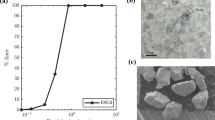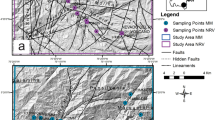Abstract
The determination of porosity and permeability distribution along the reservoir is very important and can be determined by different field and laboratory experiments, i.e., core flooding experiments, seismic and well log data, well testing. At the field level, however, information regarding spatial distribution of porosity and permeability is very sparse, and additional techniques such as geostatistics and correlations may be used. The literature presents a variety of correlations between permeability and porosity, considering different parameters, such as probability distribution functions and tortuosity of porous media. General behavior of porous media, however, can be described with a normal distribution for porosities and log-normal distribution for permeabilities. This paper proposes the use of a simplified empirical equation to represent the correlation between porosity and permeability. Methodologies to derive the empirical parameters from experimental data, or desired ranges of porosities and permeability are proposed and applied. Considerations regarding range of validity of this correlation are made by the use of a steady-state single-phase reservoir simulation. Results show that the procedures for the creation of maps of permeability, obtained from the empirical correlation, provide a reasonable distribution of values and represent well the observed data from the laboratory. The procedure for the creation of synthetic fields, obtained by fixing values of maximum and minimum permeabilities, also shows good results and can be a faster way to create synthetic field cases. Regarding the application of these correlations for upscaling, results show that the correlation remains valid when the scale is increased. Numerical dispersion can, however, be observed. The errors obtained, however, increase significantly when permeability ranges increase, meaning that the correlation can only be used with confidence when no significant variations in porosity and permeability are present. Although the literature shows other methodologies for estimating upscaling values of permeability, the approach proposed here is easier and faster to be implemented and may be used in a complementary way for field-level upscaling.























Similar content being viewed by others
Abbreviations
- \(A, \,B\) :
-
Coefficient for empirical correlation
- \(a,\, b, \,c, \,d,\, e, \,f, \,h,\,m,\, Z\) :
-
Parameters for generation of 2D 5-spot porosity map
- \(g\) :
-
Acceleration of gravity (m/s2)
- \(H\) :
-
Height of grid block (m)
- \(k\) :
-
Absolute permeability
- \(L\) :
-
Length of core sample
- \(p\) :
-
Pressure (kPa)
- \(x, y\) :
-
Spatial coordinates in the 2D porosity map
- \(\mu\) :
-
Viscosity (cp)
- \(\rho\) :
-
Specific mass (kg/m3)
- \(\phi\) :
-
Porosity (fraction
References
Cosentino L. Integrated reservoir studies. Paris: 2001. xxi, 310 p. (Institut Français Du Pétrole Publications). ISBN 9782710807971
Zhao S, Zhou Y, Wang M et al (2014) Thickness, porosity, and permeability prediction: comparative studies and application of the geostatistical modeling in an Oil field. Environ Syst Res 3:7. https://doi.org/10.1186/2193-2697-3-7
Collins RE, Jordan JK (1961) Porosity and permeability distribution of sedimentary rocks. Soc Pet Eng. SPE-212-MS 29
Hirasaki GJ (1984) Properties of log-normal permeability distribution for stratified reservoirs. Soc Pet Eng. SPE 13416-MS
Chilingar G, Long W (2017) Correlation between porosity and permeability of carbonate rock reservoirs. Energy Sources Part A Recovery Util Environ Eff 39(11):1116–1117. https://doi.org/10.1080/15567036.2017.1297874
Chilingarian GV, Chang J, Bagrintseva KI (1990) Empirical expression of permeability in terms of porosity, specific surface area, and residual water saturation of carbonate rocks. J Pet Sci Eng 4(4):317–322. https://doi.org/10.1016/0920-4105(90)90029-3 (ISSN 0920-4105)
Lima MCO, Pontedeiro EM, Ramirez M et al (2020) Petrophysical correlations for the permeability of coquinas (carbonate rocks). Transp Porous Med 135:287–308. https://doi.org/10.1007/s11242-020-01474-1
Ling H, Lun Z, Jianxin L, Ji M, Ruilin L, Shuqin W, Wenqi Z (2014) Complex relationship between porosity and permeability of carbonate reservoirs and its controlling factors: a case study of platform facies in Pre-Caspian Basin. Pet Explor Dev 41(2):225–234. https://doi.org/10.1016/S1876-3804(14)60026-4 (ISSN 1876-3804)
Lamas LFO (2014) Comparação entre Estratégias de Produção para Projetos de Injeção de Água e de Polímeros (Comparison of Number and Position of Wells for Water and Polymer Flooding Projects), School of Mechanical Engineering and Institute of Geosciences – University of Campinas. Campinas, p. 132. MSc Dissertation. (In Portuguese)
Equinor Volve Data (2020) “Volve field data set download”. Available at <https://www.equinor.com/en/how-and-why/digitalisation-in-our-dna/volve-field-data-village-download.html> Access in October 2020
Ringrose P, Bentley M (2015) Reservoir model design: a practitioner’s guide. Springer, New York, NY, p 249 (ISBN 9789400754966)
Odsæter LH, Berg CF, Rustad AB (2015) Rate dependency in steady-state upscaling. Transp Porous Med 110:565–589. https://doi.org/10.1007/s11242-015-0573-y
Blunt M (2017) Multiphase flow in permeable media: a pore-scale perspective. Cambridge University Press, Cambridge. https://doi.org/10.1017/9781316145098
Honarpour MM, Cromwell V, Hatton D, Satchwell R (1985) Reservoir rock descriptions using computed tomotraphy (CT). In: Annual Technical Conference and Exhibition (ATCE). Las Vegas, NV, USA, 22–25. https://doi.org/10.2118/14272-MS
Castro DMH, Vidal Vargas JA, Koroishi ET, Lamas LF, Trevisan OV (2019) Porosity and permeability alteration of carbonates by CO2-enriched brine injection. Mater Sci Forum 965:107–115
Rocha EFM, Trevisan OV, Koroishi ET, Vidal Vargas JA, Lamas LF (2019) Porosity alteration of carbonates by CO2-enriched brine injection. Mater Sci Forum 965:69–77
Al-Mudhafar WJ (2020) Integrating machine learning and data analytics for geostatistical characterization of clastic reservoirs. J Pet Sci Eng 195:107837. https://doi.org/10.1016/j.petrol.2020.107837 (ISSN 0920-4105)
Bocanegra RRN (2017) Investigation of dissolution effects on dolomite porous media under carbonated water injection. Master dissertation. University of Campinas. Campinas, SP, Brazil
Acknowledgements
The authors are grateful to the University of Campinas (UNICAMP), the Center of Petroleum Studies (CEPETRO), and the National Brazilian Petroleum, Gas and Biofuels Agency, ANP for their support to accomplish this work. The authors thank CMG for the software support.
Author information
Authors and Affiliations
Corresponding author
Additional information
Technical Editor: Celso Kazuyuki Morooka.
Publisher's Note
Springer Nature remains neutral with regard to jurisdictional claims in published maps and institutional affiliations.
Rights and permissions
About this article
Cite this article
Lamas, L.F., Ruidiaz, E.M. & Vidal, A.C. Study of empirical correlation between permeability and porosity with application for permeability upscaling. J Braz. Soc. Mech. Sci. Eng. 43, 530 (2021). https://doi.org/10.1007/s40430-021-03227-7
Received:
Accepted:
Published:
DOI: https://doi.org/10.1007/s40430-021-03227-7




